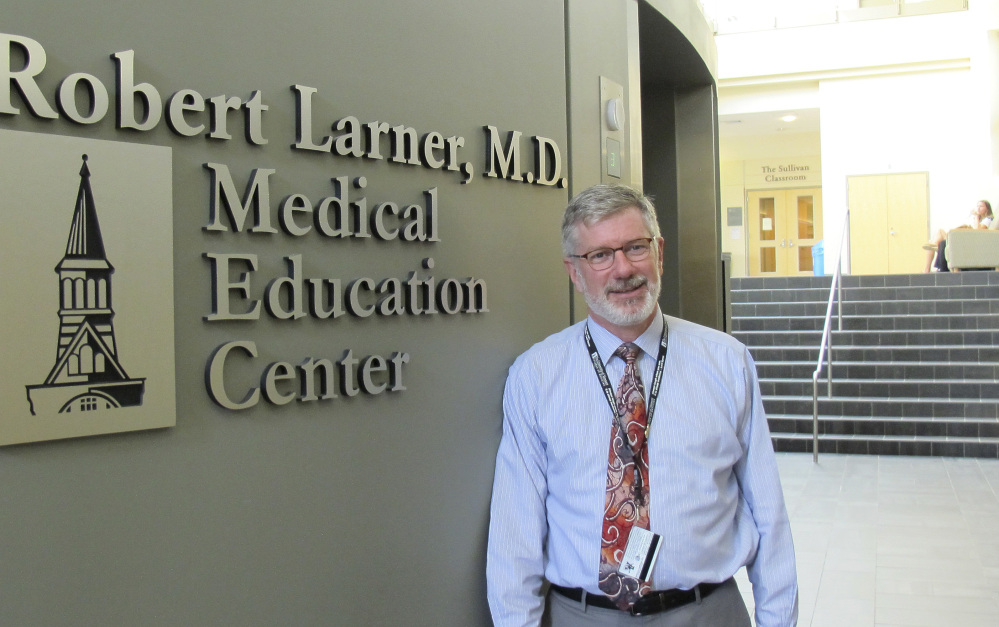BURLINGTON, Vt. — The University of Vermont College of Medicine is changing the way physicians are trained by switching exclusively to a hands-on approach to learning designed to encourage students to solve medical puzzles rather than just memorizing body parts and diseases.
While most medical schools recognize the importance of active learning and use it in some of their classes, UVM is believed to be among the first in the country to commit itself to switching all its medical training to the new system.
“Shifting completely away from the traditional lectures in that way, we are not familiar with any other medical school that has done that across all four years,” said Lisa Howley, the senior director of educational affairs at the Washington-based Association of American Medical Colleges, which represents 145 medical schools and about 400 teaching hospitals.
The effort will get a boost from a $66 million donation from 1942 medical school graduate Robert Larner that will provide $4 million a year in perpetuity to help implement the changes. In announcing the donation Friday, the medical school, which has about 465 students, also said it was changing its name to The Robert Larner M.D. College of Medicine.
Making the switch presents a challenge to an educational system that, especially in the early years of medical school, relied on a doctor lecturing to students from the front of the room.
William Jeffries, associate dean at the UVM medical school, points to a 2014 study in the Proceedings of the National Academy of Sciences that determined students in traditional lectures were 1.5 times more likely to fail than students taught with active learning.
“If this was a clinical trial of a new drug or a treatment, we would adopt it because we knew that the other method was inferior to the first method,” Jeffries said. “We have to react to that evidence.”
Here’s how the process works in the new system:
In class, medical students might be given a case in which a patient is complaining of arm pain. The students would focus on which bone is most likely broken and the possible implications of the injury to the circulatory or nervous system.
“That means they have to know the anatomy, and then they have to say, ‘Well, in the real world, what are we going to do with that information?” said Dr. William Raszka, a pediatrician who teaches in the medical school.
“The family doesn’t come in and say, ‘I think my ulna’s fractured.’ They say, ‘My son came in, he fell off the jungle gym and he’s holding his hand,”‘ Raszka said.
To facilitate those types of discussions, the school is removing lined-up desks from classrooms and replacing them with tables where small groups of students can apply the information they learn before class and work together to find answers to questions posed by the teachers. The rarely used books in the medical school library are going to be moved into storage and the information digitized.
The students will still be tested, but rather than focusing on memorized facts, they will be asked to solve problems and demonstrate higher levels of thinking.
For some of the students, active learning has become routine. For some of the faculty, it’s a big change.
Third-year medical student Soraiya Thura has been learning medicine under both systems.
“It’s a delicate balance,” Thura said. “Some faculty members are great at doing it, and they have a natural ability to facilitate this kind of learning.”
Raszka said there is resistance among the faculty because they are being asked to change the way things have always been done and it’s much more difficult.
“To develop active learning models takes an enormous amount of effort,” he said.
UVM is about halfway finished with fully implementing the new system. The faculty will decide on a timetable for full implementation, Jeffries said, who added that it’s important to have everyone on board.
“If you’ve gone with a coalition of the willing but not everybody all in … that’s what’s going to be the big challenge.”
Send questions/comments to the editors.



Success. Please wait for the page to reload. If the page does not reload within 5 seconds, please refresh the page.
Enter your email and password to access comments.
Hi, to comment on stories you must . This profile is in addition to your subscription and website login.
Already have a commenting profile? .
Invalid username/password.
Please check your email to confirm and complete your registration.
Only subscribers are eligible to post comments. Please subscribe or login first for digital access. Here’s why.
Use the form below to reset your password. When you've submitted your account email, we will send an email with a reset code.